Utah Centennial Studies

Once Upon A Time...Buildings Tell a Story Packet A
 Dictionary of Architectural Terms
Dictionary of Architectural Terms
prepared by Ann Whitehead
 Acanthus
Acanthus
A thistle-like plant (common to the warm Mediterranean region) whose
narrow and pointed-lobed leaves, when stylized, form the characteristic
decoration of the Corinthian and Composite Orders of columns.
Adobe
Unfired brick, dried in the sun. Adobe is made of clay, water, and usually
a bonding material such as straw, hay, or gravel. Because adobes are handmade,
their shapes and sizes are frequently irregular. Old adobe has an old,
soft look due to the weathering that has occurred.
As they planned their cities, the Mormon pioneers agreed that their houses should be built of "sundried, clay adobes, after the manner of the Spanish." A block of land was set aside for an adobe yard. Regulations were adopted governing the width of sidewalks, setbacks for houses, and the use of adobe for building material. Since timber in any quantity was scarce and had to be hauled long distances, adobe was the most practical building material and was favored by Brigham Young.
Because of its availability and perhaps because of Brigham Young's approval, adobe was the most widely-used building material in the early Mormon settlements. President Young also wanted the Salt Lake Temple built of adobe, but was eventually convinced that it was not structurally strong enough to support the great weight and height of the walls.
Adobe buildings were quickly constructed. In his journal, William Clayton tells that on Sunday, August 8, 1847, "110 of the brethren were selected to make adobes." By December of that year, John Taylor reported that nearly 700 houses had been finished or were in the process of being built.
The first adobe was of poor quality, probably due to the lack of the pioneers' experience in choosing the best clay and possibly due to their failure to let the brick cure properly -- since houses were needed quickly before winter struck.
Advantages of adobe were the widespread availability and inexpensiveness of the raw materials. Skilled labor was not required to make the brick. Whole families helped to make enough adobies during the hot summer months to provide for the year's construction projects.
A loamy-clay soil made the best adobe. If the clay content was too high, the adobe tended to shrink or crack during the drying process. If too sandy, the bricks crumbled and did not bond well. Many pioneers dug the clay from their own land and subsequently used the pit for a cellar. Undoubtedly, many experienced great satisfaction with the achievement of building these homes in the desert, as told by Rachel Simmons in her journal:
Father and the boys went right to work making adobes for a house, and before the winter set in he had selected ... lots and put up two rooms so that we were very comfortable. Took the wagon to pieces and made floors. The roof was made of brush with dirt thrown in ... Father takes great credit to himself this day, for that house building. It certainly was well and quickly done. The first step in making adobe was choosing a suitable clay. Then the soil was thoroughly soaked with water and mixed with bare feet until it was thick and gooey. Next straw was mixed in. The main contribution of straw was to promote uniform drying and reduction of shrinkage during the drying. Only small amounts of straw should be added because studies have shown that "the addition of organic material weakens adobe in direct proportion to the amount added. " The mud mixture was packed into wooden molds. The simple frame molds were without tops or bottoms and helped to make the adobe bricks a uniform size and shape. After smoothing off the frame, it was placed on a smooth, sandy surface. The frame was carefully lifted off and the brick left to dry in the sun. By working from sun-up to sun-down, a man could make as many as 500 adobes in a day.
People unskilled in masonry could make adobe, but a mason was often necessary to lay up the walls properly, especially as larger and more permanent buildings were constructed. The adobes were laid up with a mud mortar, made of the same clay as the adobes.
After communities became established, commercial adobe yards were started and produced excellent adobe. Each yard standardized the color, size, and shape of its own bricks, but a standard was not set up for the whole territory. Now the supply of bricks was not limited to what an individual could produce or barter for.
Adobe is fireproof. Its greatest disadvantage was its need for protection from weather -- it disintegrated in rain or snow. To protect it, it was stuccoed with thick plaster. It also cracked and was not as strong as fired brick (see BRICK).
A versatile material, adobe was used for buildings of many kinds. The pioneers built their own houses, sheds and granaries on their land and banded together to make the adobes for their early forts, schools, meetinghouses and public buildings.
Apse
See CHURCH ARCHITECTURE.
Architrave
See ENTABLATURE.
Arcade
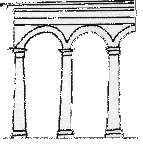 A series or
row of arches carried on columns or piers. The outward thrust of each
arch meets and balances the thrust of the next arch in the series. (See
ARCH. )
A series or
row of arches carried on columns or piers. The outward thrust of each
arch meets and balances the thrust of the next arch in the series. (See
ARCH. )
Arch
A structure built to support the weight above an opening. A true arch
is curved. It consists of wedge-shaped stones or bricks called VOUSSOIRS
(vu-swar'), put together to make a curved bridge which spans the opening.
PARTS OF AN ARCH
K Keystone
V Wedge-shaped arch stones (vous-soir)
S Springers or skewbacks
C Crown (highest part of an arch)
H Haunches (sides of the arch)DEVELOPMENT OF THE ARCH
Builders in Babylonia or Assyria were building brick arches and vaults before 3000 B.C. The following describes the development of the arch.
Beam and Lintel Arch is made by bridging two columns with a heavy piece of wood (beam). It will not support a very heavy load.
Corbelled Arch. The arch is stronger if the upper part of the wall is sloped inward by extending each course of bricks inward progressively as the wall is built higher. Now it is possible to bridge the span with a shorter beam, which is stronger and will carry a heavier load.
True Arch. This arch is stronger still. The keystone (central, locking stone) bears the weight of the stones pressing down from above. This pressure in turn pushes on the stones or bricks next to the keystone on both sides. This pressure (thrust) is relayed from stone to stone, down both sides of the arch until it reaches the bottom blocks (springers) and then is carried down the piers to their foundations and into the ground. If the arch is too long, or if the piers at the ends are too light, the outward thrust will push the sides out and the top will cave in. If the arch is too light at the top, or too heavy at the sides, the sideward thrust of the arch walls will push the top up, and the sides will cave in.
HOW AN ARCH IS BUILT
When the supporting piers are finished, a wooden framework of the desired finished dimensions (called a CENTERING) is placed on top of the piers. The masons start at the bottom of the arch and place wedge-shaped bricks or stones (voussoirs) on the centering with mortar. Continuing up the centering until the top is reached, the keystone is set in to lock the arch together. When the mortar is dry, the centering is removed.
ARCHES VARY IN SHAPE
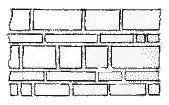
Ashlar
Stone, usually larger than brick, that has been square-cut so that the
exposed faces are rectangular. Mortar joints are thin.
Attic
A room, usually with sloping ceilings, just beneath the roof; also, a
garret.
Balconet
A pseudo-balcony. A low, ornamental railing which projects only slightly
beyond a window sill.
Balcony
A platform projecting from the wall of an upper story, enclosed by a railing
or balustrade, with an entrance from the building and supported by brackets,
columns, or cantilevered out.
 Baluster
Baluster
A short, upright column or urn-shaped support of a railing.
Balustrade
A row of balusters and the railing connecting them. Used as a stair rail
and also above the cornice on the outside of a building.
 Bargeboard
Bargeboard
A decorative board covering the projecting part of a gable roof. The ornamental
designs are cut with a saw, not carved. A characteristic of residential
Gothic Revival Style. Also, vergeboard and "gingerbread ."
Barrel Vault
See VAULT.
 Bay Window
Bay Window
A window or set of windows which project out from a wall, forming an alcove
or small space in a room; ordinarily begins at ground level, but may be
carried out on brackets or corbels. A BOW WINDOW is a rounded or curved
bay.
Belt Course
A course (horizontal layer) of stone or brick, flush with the wall or
projecting from an exterior, masonry wall; used to mark a floor line or
visually to reduce the height of a building. Generally narrower than the
other courses.
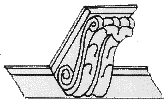 Bracket
Bracket
A supporting member designed to carry a projecting weight, e.g. a cornice,
shelf, floor. Sometimes shaped like an inverted "L"; sometimes very decorative
or using a human head-like form.
Boss Stone
An ornamental
knob or other projection which covers the intersection of ribs in a ribbed
vault.
Brick
A construction material made of clay or a clay mixture that has been hardened
into a block by drying in the sun (adobe) or by baking in a kiln (burned
or fired). Uniformity of size and shape of the blocks reduces the difficulty
of building with the bricks. Brick is the oldest manufactured building
material. As early as 4000 B.C., Egypt, Assyria and Babylonia were using
sun-dried bricks (similar to Utah's adobe). The Israelites' main occupation
during captivity was making sundried bricks from the clay of the River
Nile. Some of the first bricks were molded by hand into oval lumps. The
development Of rectangular wooden frames to press the mud into made a
more uniform block possible. Bricks were still sun-dried. Firing (or burning)
bricks came as a natural result of pottery-making. Bricks burned in a
fire, or later, in a kiln or furnace, were harder and more durable.
TERMS USED IN BRICK MASONRY
Burned brick or kiln dried brick. After the bricks are dried, they are burned or fired at a high temperature. The clay particles are partly melted and fuse together, making the brick stronger and harder. Burned brick was first used in Utah in the 1860's.Course. Bricks are usually laid on their flat sides to form horizontal layers called courses and are bonded together with MORTAR.
Bonds. Different arrangements of STRETCHERS and HEADERS.
Stretchers. Bricks laid with only the long side showing on the face of the wall.
Headers. Bricks laid with only the end showing on the face of the wall.
EXAMPLES OF BONDS

Stretcher Bond (Running Bond) is an arrangement of bricks in which all bricks are stretchers.
American Bond (Common Bond) is an arrangement of four to six stretcher courses between single header courses.
English Bond is an arrangement of bricks with alternate courses of stretchers and headers, with the joints in alternate courses lining up vertically.
Flemish Bond is an arrangement Of bricks in which each course consists of alternating headers and stretchers.
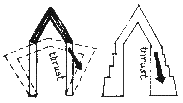 Buttress
Buttress
A masonry support built against an exterior wall of a building to give
additional support. Buttresses absorb lateral thrusts from roof vaults.
Found in Gothic Revival church architecture.
Flying Buttress.
An arch or half-arch which carries the thrust of a vault or roof from the upper part of the wall to an outer buttress and from there down into the ground. Found in Gothic Revival church architecture.
Cement
A substance made by burning a mixture of clay and limestone. Cement is
one of the ingredients in CONCRETE.
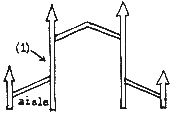 Clerestory (klir' stor i)
Clerestory (klir' stor i)
(1) is the upper part of the wall of a church (above the roofs of the
aisles ) having windows in it; also, the windows in that wall.
 (2) in contemporary
architecture, an upper part of a wall whose windows allow light into the
center of a high-ceilinged room.
(2) in contemporary
architecture, an upper part of a wall whose windows allow light into the
center of a high-ceilinged room.
A. Apse. Semicircular room at the end of the central aisle of a church; usually houses the altar.
B. Transept. (Latin: "trans" - across, through) Transverse arm of cruciform (cross shaped) church crossing the nave at a right angle; shorter arm of a church.
C. Nave. Central part of a church, leading from the entrance to the crossing; intended for the laity.
D. Crossing. The space at the intersection of the nave and the transept.
E. Narthex. Enclosed porch or vestibule between the entrance of a church and the nave.
 Coffering
Coffering
Decorative pattern on the underside of a ceiling, dome or vault, consisting
of sunken square or polygonal (many angles) panels. Reduces the weight
of the ceiling but does not weaken it.
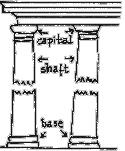 Colonnade
Colonnade
A row of columns supporting an entablature and usually one side of
a roof.
Column 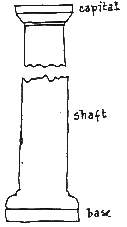
A vertical structure, usually circular in form (but may be molded on any
regular geometrical figure), designed to support an entablature or other
weight above it. Used to strengthen and decorate a building, it may be
made of any building material; e.g., stone, wood, metal, marble, and brick.
Columns in classical architecture follow certain specifications of design
and proportion (see ORDER). A column has three main parts:
A. The base or lowest part.
B. The shaft, or central, trunk-like section.
C. The capital or top, crowning feature.
A column, usually cylindrical in shape and usually conforming to an Order, is somewhat different from the following:
Pillar.
A free-standing, upright member which, unlike a column, need not by cylindrical or conform to any of the Orders.
Pier.
A solid masonry support, distinct from a column. May vary from a simple square shape to a compound pier which can have several shafts, either attached or detached.
Pilaster. (pelas' ter or pi' las ter)
A flat, rectangular pillar or pier with capital, shaft, and base, forming part of a wall from which it projects slightly. May be a supporting member or only a decorative element.Half-column.
An engaged (attached ) column projecting slightly from the wall a little more than one-half its diameter.
 Concrete
Concrete
Mixture of crushed stone or gravel, sand, CEMENT, and water that hardens
as it dries and attains a strength not unlike stone. First used by the
Romans.
Reinforced concrete is concrete with steel embedded in it to add strength to the mass. An ordinary concrete slab sags, squeezing the top part of the slab together and pulling the lower part of the slab apart. If the load is too heavy, the slab breaks in two.
 Steel rods embedded
near the bottom when the concrete is poured reinforce the concrete by
taking up most of the pull.
Steel rods embedded
near the bottom when the concrete is poured reinforce the concrete by
taking up most of the pull.
 Cornice
Cornice
Any molded projection which finishes or crowns the part to which it is
attached.
 Crocket
Crocket
A carved ornament, usually made to look like foliage, projecting upward
at regular intervals along the sloping edges of a spire, pinnacle, gable,
canopy, etc., especially in Gothic Revival architecture.
Cross, Groined Vault
See VAULT
 Cupola (kupe le)
Cupola (kupe le)
A small dome on a tower or a roof..
Dormer Window
A small house-like structure that projects from a roof and includes a
window. A method of admitting light and air to the attic, which was first
used for sleeping space. (Dormer comes from the Latin dormio - to sleep.
) Seen in great variety in Salt Lake City. The roofs of most dormers are
miniatures of large roof types, e . g . -

Gable dormer

Hip dormer

Shad dormer

Cornice line dormer
Some of the more unusual dormer types are:

Dixie dormer

Round Dixie dormer

Eyelid or Eyebrow dormer

Porthole or Round dormer

Eaves
The underside of a sloping roof projecting beyond the wall of a building.
Entablature The part of a classical building between the tops of the columns and the roof; consists of three main parts:
A. Architrave . The lower horizontal section which connects the columns.
B. Frieze. The middle section, often decorated with sculpture, figures,
or left plain.
C. Cornice. The top section which projects out to support the edge of
the roof.
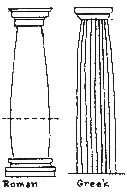 Entasis
Entasis
The very slight convex (curving out) curve used on columns to correct
the optical illusion of concavity (curving in) which would result if the
sides were straight. Dotted lines in illustration show how the Romans
and Greeks built columns differently.
Facade
Front or principal face of a building; any side of a building that faces
a street or other open space.
 False Front
False Front
Early Mormon commercial and public buildings were built with the gable
end parallel to the street. An attempt at sophistication was made by adding
a prefabricated facade to the street-facing, gable end of the building.
Easily constructed. Most often found in mining boom towns rather than
in Mormon farming communities. A front wall which extends beyond the sidewall
to create a more imposing facade.
Fenestration
The arrangement of windows in a building to provide interior light; also
used as decorative elements in a facade.
 Gargoyle
Gargoyle
A water spout projecting from a roof and ending in a grotesque figure,
either human or animal.
 Gable
Gable
The triangular upper- portion of a wall at the end of a pitched roof.
The base of the triangle is not completed by any horizontal member as
with a pediment.
Keystone
See ARCH.
Kiln
A furnace or oven for burning limestone to make lime; or a
furnace for firing bricks.
 Lintel
Lintel
A heavy horizontal beam of wood or stone over an opening of a door or
window to support the weight above it.
Mortar
A mixture of sand, lime and water used to cement stones and bricks together.
When it dries it becomes very hard. The early Mormons used the same mud,
in more liquid form, for mortar that they used to make adobe.
Niche
A recess in a wall, usually made to contain a sculpture or
an urn.
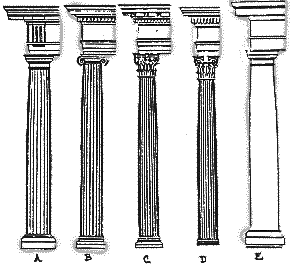 Orders
Orders
Styles of columns and architecture having different proportions, decorations,
etc. There are five Classical Orders. Three of them are Greek: Doric,
Ionic, and Corinthian (DIC). The remaining two, Composite and Tuscan,
were developed by the Romans. The three Greek orders and the Roman Composite
all have FLUTES (vertical grooves in a series encircling the shaft). The
Tuscan has an unadorned shaft. The most effective way to differentiate
among them is by describing the capitals in general terms.
A. Doric. Capital is plain.
B. Ionic. Capital is decorated with VOLUTES (scrolls-
which look like "eyes", "I" for Ionic).
C. Corinthian. Capital is decorated with acanthus
leaves.
D. Composite. Capital is decorated with a combination
of Ionic scrolls and Corinthian leaves .
E. Tuscan. Capital is plain. This order is a simplified
Roman Doric column.
 Pediment
Pediment
A low-pitched gable over a portico taking the shape of a triangle and
formed by the sloping roof and a horizontal cornice at the base of the
triangle. If the horizontal cornice is lacking, the space is a gable.
This form is found over doors and windows.
Pinnacle
See TALL STRUCTURES.
Porch
A covered entrance to a building; may be open or partly enclosed.
 Portico
Portico
A porch or covered walk consisting of a roof supported by columns.
 Quoin (koin)
Quoin (koin)
Dressed stones or bricks at the corners of buildings, laid so that their
faces are alternately large and small. Originally used to add strength
to the masonry wall, later used decoratively. Sometimes imitated in wood
as in Carpenter Gothic.
Ribbed Vault
See VAULT.
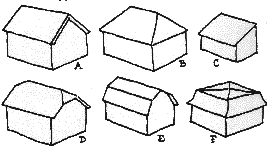 Roof
Roof
The top covering of a building. Following are some types:
A. Gable roof has a pitched roof with ridge and
gable ends.
B. Hip roof has sloped ends instead of vertical
ends.
C. Shed roof (lean-to) has one slope only and
is built against a higher wall.
D. Jerkin-head (clipped gable or hipped gable)
is similar to gable but with the end clipped back.
E. Gambrel roof has a double slope on two sides,
the lower slope being longer and steeper.
F. Mansard roof has a double slope on all four
sides, the lower slope being longer and steeper than the upper. Named
after Francois Mansart.
 Rose Window
Rose Window
A circular window with tracery arranged like the spokes of a wheel;
found in Gothic Revival church architecture.
Rubble
Field stone or rough stones of irregular shapes and sizes; generally not
laid in courses. In pioneer Utah, facade walls were often laid with dressed
and coursed stone and the back and side walls were laid with rubble which
was easier and quicker to lay up.
 Rusticated Stone
Rusticated Stone
Cut stone, with smooth or roughly textured block faces, with deeply recessed
mortar joints which create a deep shadow line; the effect is a bold appearance.
 Salt Box
Salt Box
A square or rectangular house with a lean-to added to the back to provide
more living space,. frequently a kitchen. The roof continues in a straight
line from the roof ridge (1), or there may be a slight angular break (2).
The term derives from the similarity of the house shape to the wooden
box in which salt was kept in colonial kitchens.
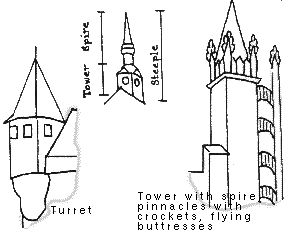
Tower. A building characterized by its great
height. May stand alone or be part of a castle, church, or other building.
Often square, but may be cylindrical.
Spire. A tall, slender pointed structure that
rises from a tower, turret, or roof (usually a church). May be pyramidal,
polygonal, or conical.
Steeple. The combination of a tower and a spire.
Turret. A small tower, often on the corner of
a building. Sometimes beginning at some height above the ground.
Pinnacle. The apex or high point. A small, slender
turret or spire usually terminating in a pyramid or cone, ornamented
sometimes with CROCKETS, and crowning a buttress or rising above the
roof of a building.
Terra Cotta
A ceramic (clay) product used for covering and ornamenting the exterior
of a building.
 Tracery
Tracery
The ornamental stonework in a Gothic window which frames the stained glass
and is the design seen from the outside of the building.
Tympanum
Triangular space enclosed by a pediment and usually carved. Also, may
be a segmental (curved) space bounded by an arch. See PEDIMENT.
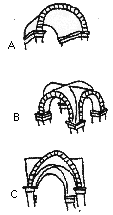 Vault
Vault
A ceiling, of stone or brick (sometimes imitated in wood or plaster) which
is based on the shape of the arch.
A. Barrel or Tunnel Vault. The simplest form of
vault, it is a continuous series of semicircular arches extended to the
desired length.
B. Groin or Cross Vault is formed by joining two
identically-shaped barrel vaults at right angles.
C. Ribbed Vault. A framework of diagonal arches,
called RIBS, that project from the surface and carry the sections (WEB)
which fill in the spaces between the ribs. Ornamental boss stones cover
the intersections. Used in Gothic architecture, they reduced the amount
of solid masonry that had always had to be used for exterior walls. Now
the building could be supported by slender piers and the open areas between
the piers could be and usually were filled with decorative glass. The
Gothic church had a light, lofty feeling. (See BUTTRESS.)
Whitewash
A liquid of lime and water, or of whiting (preparation of finely powdered
chalk) and size and water. Used as an inexpensive substitute for paint.
Widow's Walk
A walkway or narrow platform on a roof of a house on a seacoast,
giving a good view of the ocean. New England seafaring men built widow's
walks on their houses to give their wives a place from which to watch
for returning -- or not returning (hence the name)-- ships.
Produced by Utah Heritage Foundation Public Awareness Committee 1980
Utah Heritage Foundation 355 Quince Street Salt Lake City, Utah
84103
The Public Awareness Committee of Utah Heritage Foundation provides slide lectures, films, and tours for schools and the public, in an effort to :
- Heighten interest in Utah history, developing in people a sense of their personal place in time.
- Awaken in citizens of all ages an appreciation and concern for their community and its design.
- Create in people a sense of ownership in their community and their individual neighborhoods.
- Arouse in people an aesthetic and cultural awareness of their environment.
Acknowledgements for this booklet go to Ann Whitehead, Utah Heritage Foundation docent, whose term paper for a University of Utah class in Utah's Architectural Heritage '--taken as part of docent training--provided the manuscript; to Dr. Peter Goss, who teaches that class and approved the manuscript; and to Stephanie Churchill, who did the drawings and the graphic lay-out. The booklet is presented as an aid to docents, to teachers, to anyone making discoveries in a new world--Architecture.


 UTAH EDUCATION NETWORK
UTAH EDUCATION NETWORK

 Justin
Justin Braxton
Braxton Dani
Dani Kayla
Kayla Katie
Katie Matthew
Matthew Rob
Rob Val
Val







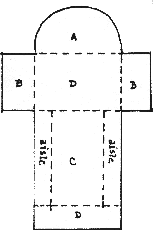 Church Architecture
Church Architecture